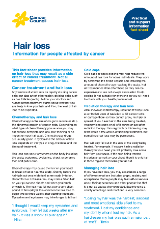- Home
- About Cancer
- Managing side effects
- Hair loss
- Managing hair loss
Managing hair loss
Learn how to address and manage hair loss with confidence. Explore strategies, support, and tips for navigating this common condition.
Learn more about:
Overview
If you have hair loss, you may experience a range of different emotions including anger, anxiety and acceptance. Some people may feel self-conscious about their appearance and other people find that it is not as bad as they expected. Experiencing a variety of feelings and reactions is very common.
Some people don’t know how to react to your hair loss. If you are uncomfortable talking about it, give a simple response, for example “I’m having some treatment for my health and this is the side effect.”
You may also want to help children if they have feelings of fear or anxiety. See Talking to kids about cancer for tips on tips on how to talk to children about the changes cancer treatment may cause, including hair loss. You can also call Cancer Council 13 11 20 for other recommended resources.
Taking back some control
Being prepared, talking about how you feel and planning ahead for how to deal with the possibility of treatment-related hair loss may be helpful.
- Consider cutting your hair before treatment starts to give yourself time to adjust. Some people cut their hair short, while others prefer to cut their hair in stages.
- Some people choose to shave their head at the early stages of hair loss when they start to notice larger amounts of hair falling out.
Taking care of hair and scalp during and after treatment
If you have lost your hair
- gentle massage and moisturising of the scalp using a non-perfumed lotion or emollient can help reduce flaky areas
- protect your scalp from the sun with sunscreen, a scarf or hat
- use a pillow case made from a smooth fabric such as polycotton, cotton sateen or bamboo
- you may like to wear a soft cap, beanie or turban to keep your head warm.
If your scalp is sensitive and your hair is thin
- use a gentle shampoo and conditioner
- brush your hair gently with a soft bristle brush
- dry your hair naturally or use a cool setting on the hair dryer
- avoid heated rollers, curling wands or straightening irons
- avoid harsh chemicals such as hair colouring, gel, mousse and perming agent.
If you have lost underarm hair avoid perfumed deodorants.
For information and support on cancer-related issues, call Cancer Council 13 11 20. This is a confidential service.
Losing my hair was the hardest, saddest and most emotional side effect to my treatment. I lost my confidence and my identity when I lost my hair. As a hairdresser my hair was such a major part of ‘me’!”
Tania
→ READ MORE: Wigs, turbans, scarves and hats
Podcast: Coping with a cancer diagnosis
More resources
We thank the reviewers of this fact sheet: Caitriona Nienaber, 13 11 20 Consultant, Cancer Council WA; Hayley Tuck, Clinical Health Professional, Regional Cancer Support Coordinator, Cancer Council WA; Jacqui Campbell, Nurse Manager – ICON Cancer Centre Hobart; Karen Richardson, Cancer Nurse, Regional Support Services, Cancer Council WA; Marion Bamblett, Nurse Unit Manager, Fiona Stanley Hospital WA; Molly Colussa, Coordinator Practical Support Programs, Cancer Council Victoria; Moira Waters, McGrath Breast Care Nurse, Breast Cancer Care WA; Natasha Girvan, Program Manager, Look Good Feel Better, WA & SA; Rosie Brown, Cancer Nurse, Breast Cancer Netw trangelo, Consumer SA; Tania Ward, Consumer WA.
View the Cancer Council NSW editorial policy.
View all publications or call 13 11 20 for free printed copies.

